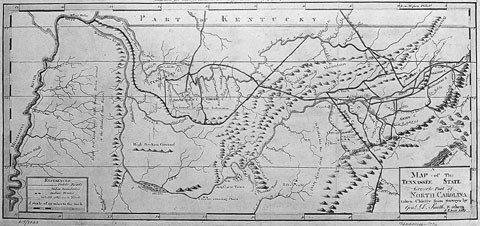
Daniel Smith, map of Tennessee, Philadelphia, 1795. Engraving on paper. 10 1/4" x 21 1/2". (Private collection; photo, John Bivins.)

Desk-and-bookcase, Winchester area, Virginia, 1795. Cherry with yellow pine. H. 103 3/4", W. 42 1/4", D. 24 1/2". (Courtesy, Colonial Williamsburg Foundation; photo, Hans Lorenz.)
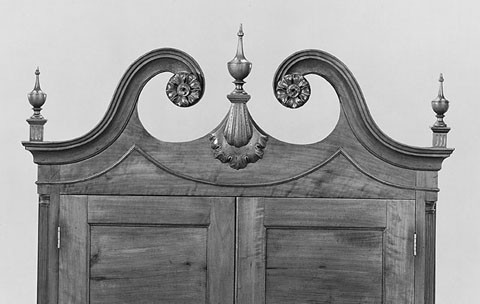
Detail of the pediment of the desk-and-bookcase illustrated in fig. 2.

Detail of the writing compartment of the desk-and-bookcase illustrated in fig. 2.
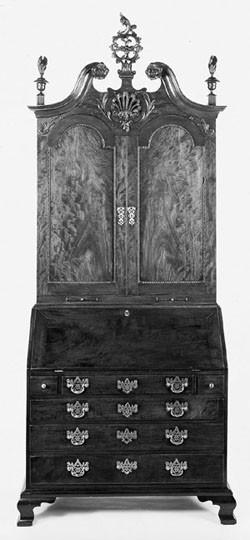
Desk-and-bookcase, Philadelphia, 1760–1770. Mahogany with tulip poplar and white cedar. H. 109 3/4", W. 45", D. 25". (Courtesy, Philadelphia Museum of Art, gift of George H. Lorimer.)
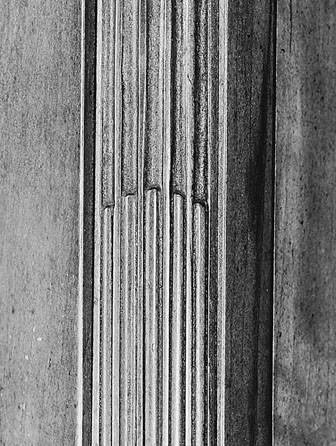
Detail of a quarter-column on the desk-and-bookcase illustrated in fig. 2.
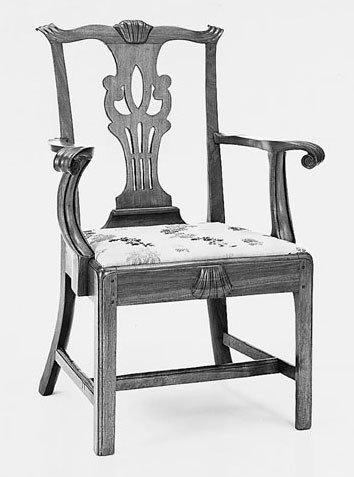
Armchair, Winchester area, Virginia, 1769. Walnut with walnut and white pine. H. 40", W. 28 3/8", D. 18 3/4". (Collection of the Museum of Early Southern Decorative Arts.)
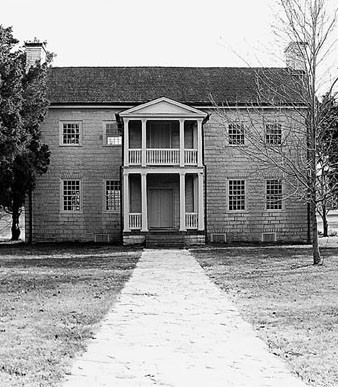
Rock Castle, Hendersonville, Tennessee, 1796. (Photo, John Bivins.)
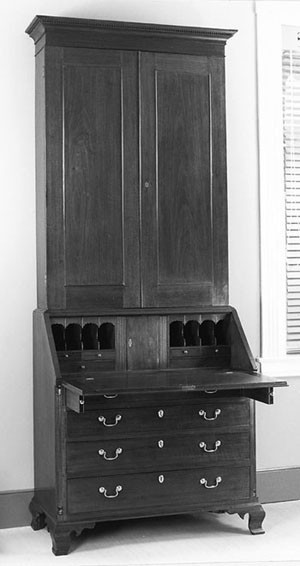
Desk-and-bookcase, Nashville area, Tennessee, 1795–1805. Walnut with tulip poplar and walnut. H. 106 9/16", W. 44 1/2", D. 22 1/2". (Courtesy, Ladies Hermitage Association; photo, John Bivins.)
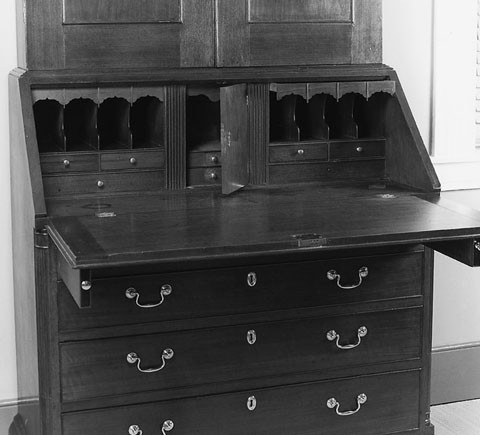
Detail of the writing compartment of the desk-and-bookcase illustrated in fig. 9.

Detail of a quarter-column and writing surface lock rail miter on the desk-and-bookcase illustrated in fig. 9.

Chest of drawers, Nashville area, Tennessee, 1795–1805. Walnut with tulip poplar.
H. 34 3/8", W. 40 5/8", D. 20 11/16". (Courtesy, Ladies Hermitage Association; photo, John Bivins.)
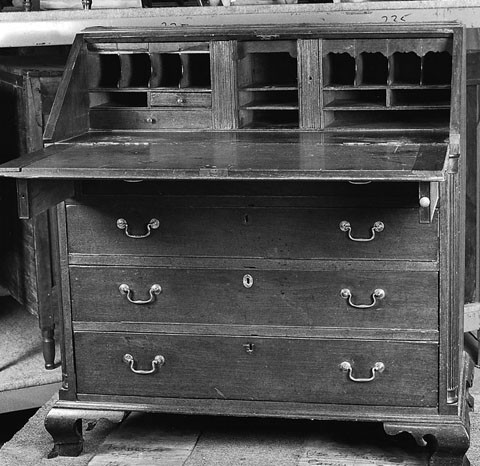
Desk, Nashville area, Tennessee, 1790–1805. Walnut with tulip poplar, walnut, and cherry. H. 45 1/4", W. 45 1/4", D. 23 3/4". (Courtesy, Tennessee State Museum; photo, John Bivins.)

Ramsey House, Knoxville, Tennessee, 1798. (Photo, John Bivins.)
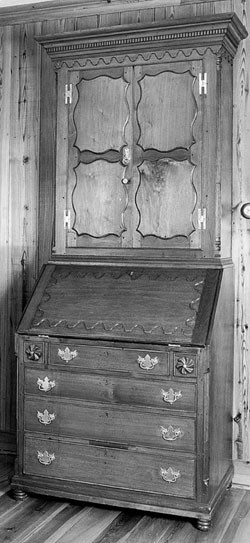
Desk-and-bookcase, Knoxville area, Tennessee, 1790–1800. Walnut with yellow pine and tulip poplar. H. 87 1/4" (without feet), W. 41 7/8", D. 35 1/4". (Private collection; photo, Museum of Early Southern Decorative Arts.) The brasses, feet, and small strip added to the bottom of the base molding are incorrect replacements.
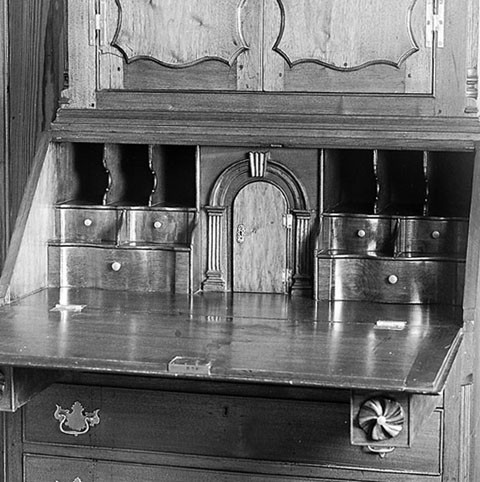
Detail of the writing compartment of the desk-and-bookcase illustrated in fig. 15.

Detail of a quarter-column on the desk-and-bookcase illustrated in fig. 15.

Detail of chamfered corner of the desk-and-bookcase illustrated in fig. 15.

Corner cupboard, Knoxville area, Tennessee, 1790–1800. Walnut with yellow pine and tulip poplar. H. 89 1/4", W. 44" at front face with 5 1/4" returns. (Private collection; photo, John Bivins.)
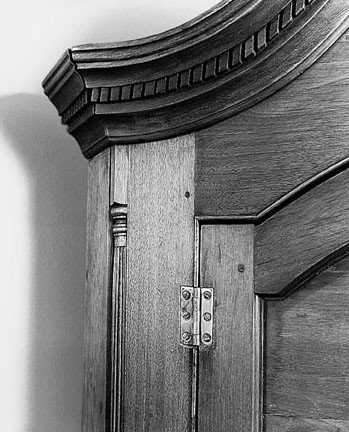
Detail of the cornice and a quarter-column on the corner cupboard illustrated in fig. 19.
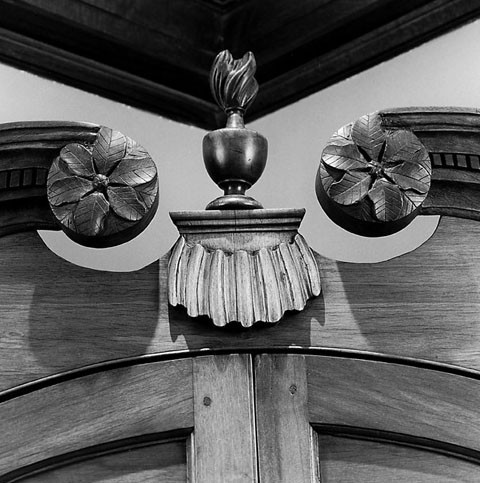
Detail of the cornice, rosettes, and plinth of the corner cupboard illustrated in fig. 19.
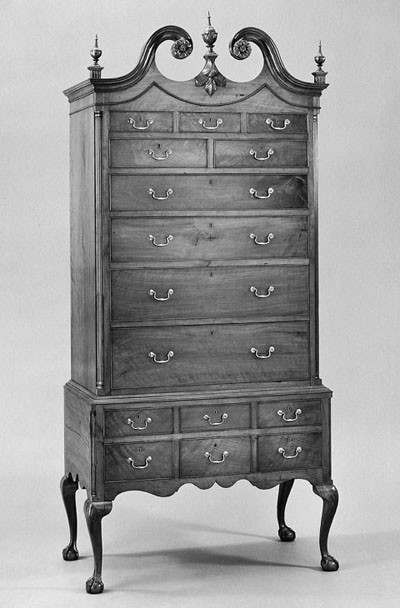
High chest, Winchester area, Virginia, 1795. Walnut with yellow pine and tulip poplar. H. 97", W. 44", D. 24 1/4". (Courtesy, Colonial Williamsburg Foundation; photo, Hans Lorenz.)

Detail of the pediment of the high chest illustrated in fig. 22.
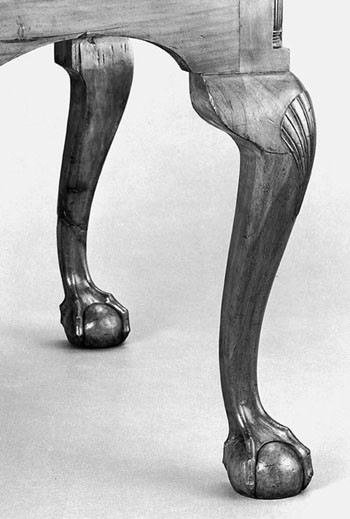
Detail of the leg of the high chest illustrated in fig. 22.
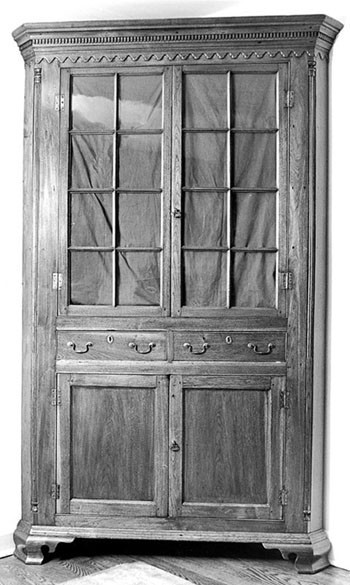
Corner cupboard, Knoxville area, Tennessee, 1795–1810. Walnut with tulip poplar. H. 87 3/4", W. 50 3/4" at front face with 5 7/8" returns. (Private collection; photo, Museum of Early Southern Decorative Arts.) The cornice molding rises above the top of the case and consists of separate moldings: the ogee below the dentil course is a single vertical piece that rises to the crown as does the dentil course; the cove is a single vertical piece attached to the dentil course; the crown is a horizontal piece that covers the top edges of the other moldings; the running astragal frieze is glued to the case below.

Detail of a quarter-column on the corner cupboard illustrated in fig. 25. (Photo, John Bivins.)
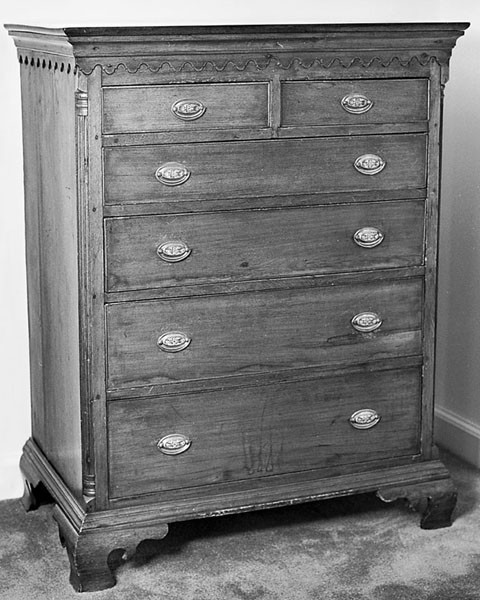
Chest of drawers, Knoxville area, Tennessee, 1795–1810. Walnut with yellow pine and tulip poplar. H. 49 5/16", W. 39", D. 23 1/2". (Private collection; photo, Museum of Early Southern Decorative Arts.) The cornice on the chest of drawers is a simpler version of the cornice on the corner cupboard illustrated in fig. 25. The molded board that forms the top of the case and the face-nailed cove molding conceal the dovetails that join the case sides to a board below the top.
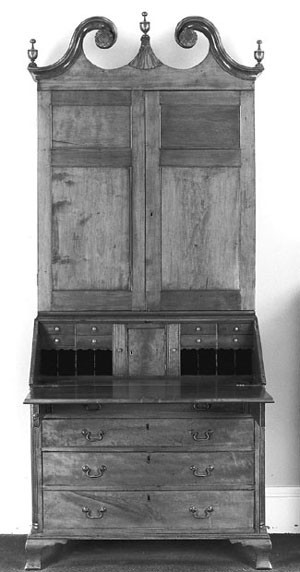
Desk-and-bookcase, Knoxville area, Tennessee, 1795–1810. Cherry with yellow pine. H. 96" (without feet), W. 42 1/2", D. 22 3/4". (Courtesy, Lawson-McGhee Library; photo, John Bivins.) This example is somewhat unusual in being made of cherry. Walnut is the most common primary wood in East Tennessee furniture.
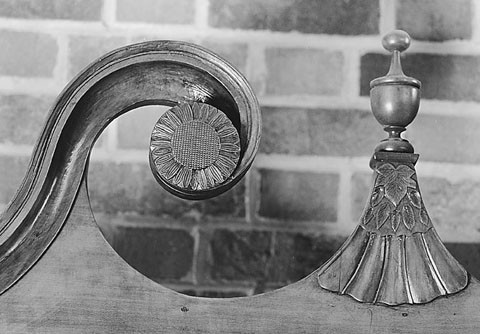
Detail of the pediment of the desk-and-bookcase illustrated in fig. 28. (Courtesy, Lawson-McGhee Library; photo, Museum of Early Southern Decorative Arts.)
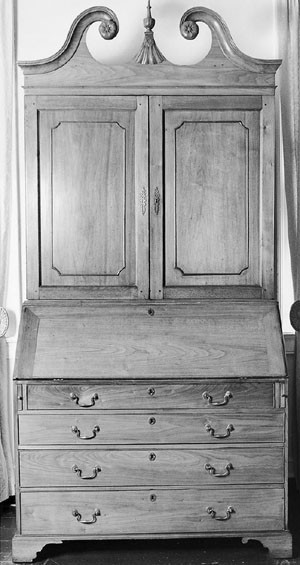
Desk-and-bookcase, Knoxville area, Tennessee, 1795–1810. Walnut with yellow pine and walnut. H. 97", W. 46 3/4", D. 23 3/4". (Courtesy, Blount Mansion; photo, Museum of Early Southern Decorative Arts.)
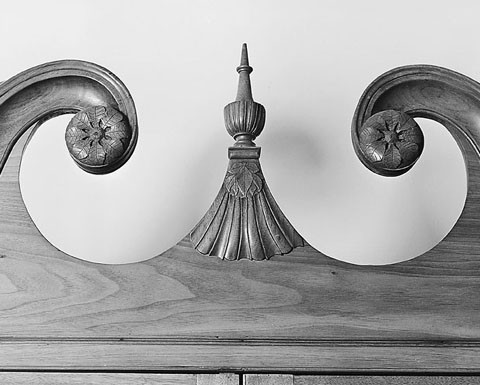
Detail of the pediment of the desk-and-bookcase illustrated in fig. 30.
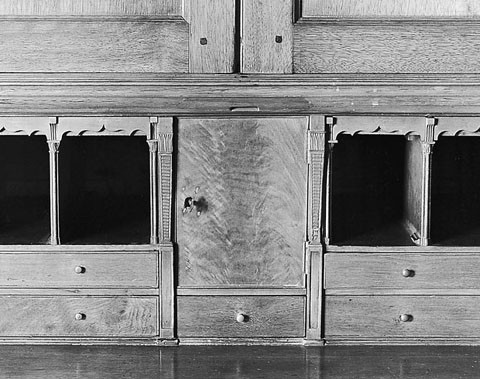
Detail of the writing compartment of the desk-and-bookcase illustrated in fig. 30.
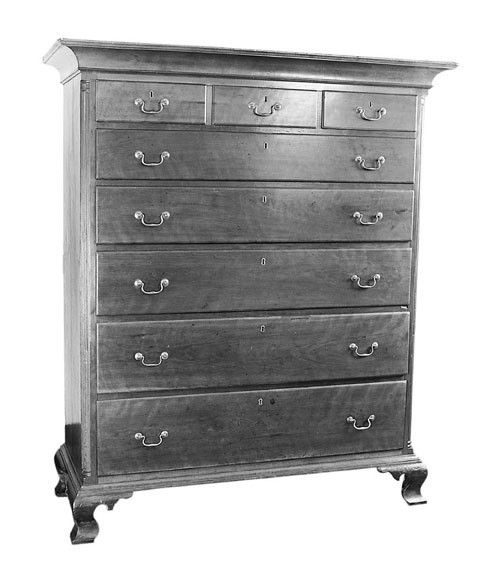
Tall chest, Knoxville area, Tennessee, 1795–1810. Cherry with yellow pine, tulip poplar, walnut, and cherry. H. 63 3/4", W. 54 3/4", D. 22 5/8". (Courtesy, Ramsey House; photo, John Bivins.)
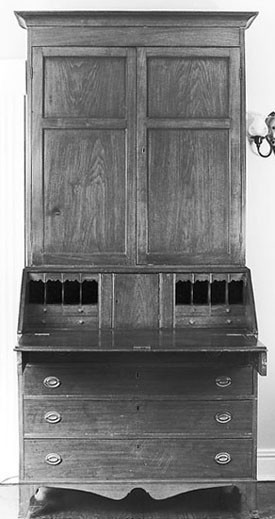
Desk-and-bookcase, Greeneville area, Tennessee, 1800–1820. Walnut with tulip poplar. H. 92 1/4", W. 45 3/4", D. 20 3/8". (Private collection; photo, John Bivins.)
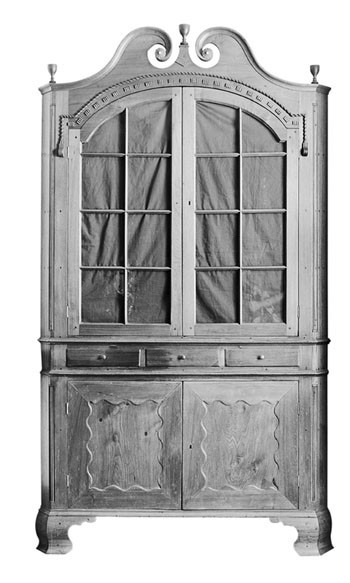
Corner cupboard, Greeneville area, Tennessee, 1795–1820. Walnut with tulip poplar. H. 95 1/4", W. 47" at front face with 4" returns. (Private collection; photo, Museum of Early Southern Decorative Arts.)
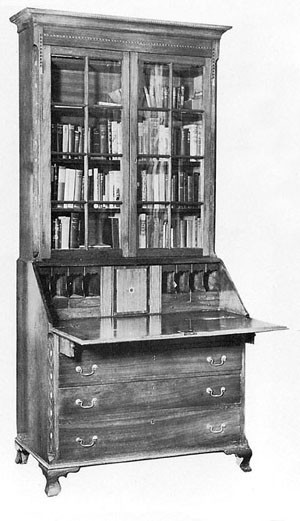
Desk-and-bookcase, Greeneville area, Tennessee, 1800–1820. Walnut with tulip poplar. H. 96", W. 44 1/2", D. 22 3/8". (Private collection; photo, Helga Studio.)
